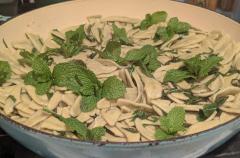 Here's a nice light pasta dish from Basilicata and Puglia to make if you have plenty of fresh mint on hand. The nights are getting cold, I expect a frost soon, so today I harvested about 10-12 mint plants.
Here's a nice light pasta dish from Basilicata and Puglia to make if you have plenty of fresh mint on hand. The nights are getting cold, I expect a frost soon, so today I harvested about 10-12 mint plants.
This is traditionally made with strascinati, a sort of stretched orecchiette common in those regions, but any short flat pasta will do.

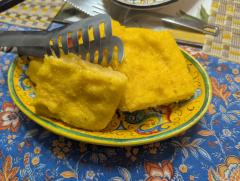 Polenta is often served soft and hot like mashed potatoes, but it's also really good baked. You cook it on the stiff side, and then spread it in a buttered pan and bake it to get it hot and puffy and a little crispy on the edges.
Polenta is often served soft and hot like mashed potatoes, but it's also really good baked. You cook it on the stiff side, and then spread it in a buttered pan and bake it to get it hot and puffy and a little crispy on the edges.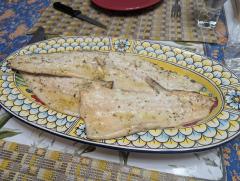 Udine is a foodie haven northeast of Venice in Friuli-Venezia-Giulia. It has its own cuisine unlike much of the rest of Italy, heavily influenced by Austiran Alpine cooking.
Udine is a foodie haven northeast of Venice in Friuli-Venezia-Giulia. It has its own cuisine unlike much of the rest of Italy, heavily influenced by Austiran Alpine cooking.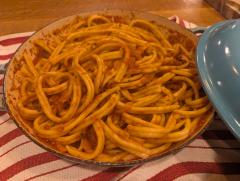 Here's a spicy treat from hot, sunny Calabria! It's a very simple recipe, but it requires one hard-to-find ingredient: 'Nduja. 'Nduja is a spicy Calabrian paste of fatty pork and fiery Calabrian chilis. The spiciness of the meat is balanced by the sweetness of the onion, which is why you want a sweeter variety like Vidalia.
Here's a spicy treat from hot, sunny Calabria! It's a very simple recipe, but it requires one hard-to-find ingredient: 'Nduja. 'Nduja is a spicy Calabrian paste of fatty pork and fiery Calabrian chilis. The spiciness of the meat is balanced by the sweetness of the onion, which is why you want a sweeter variety like Vidalia. 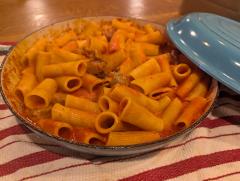 Zozzona means a hot mess in Italian, and Pasta alla Zozzone is a rich delicious crowd pleaser of a hot mess! It's loaded up with everything to alarm your cardiologist: sausage, guanciale, pecorino romano, and egg yolks. There's tomato sauce too, so that's healthy.
Zozzona means a hot mess in Italian, and Pasta alla Zozzone is a rich delicious crowd pleaser of a hot mess! It's loaded up with everything to alarm your cardiologist: sausage, guanciale, pecorino romano, and egg yolks. There's tomato sauce too, so that's healthy.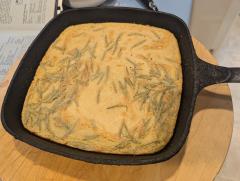 On Sunday 10 August 2025, we had our neighbors the McKinnons and the Hylanders over for a feast of two lesser-known regions of Italy: The island of Sardinia and skinny little Liguria, home of Genoa and the Cinque Terre, pressed between the mountains and the Tyrrhenian Sea.
On Sunday 10 August 2025, we had our neighbors the McKinnons and the Hylanders over for a feast of two lesser-known regions of Italy: The island of Sardinia and skinny little Liguria, home of Genoa and the Cinque Terre, pressed between the mountains and the Tyrrhenian Sea.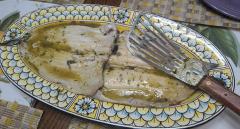 I got Ada Boni's wonderful Italian Regional Cooking many years ago and it is still one of my favorite sources of inspiration. This Sardinian dish captured my imagination probably 15 years ago and I have wanted to make it ever since.
I got Ada Boni's wonderful Italian Regional Cooking many years ago and it is still one of my favorite sources of inspiration. This Sardinian dish captured my imagination probably 15 years ago and I have wanted to make it ever since.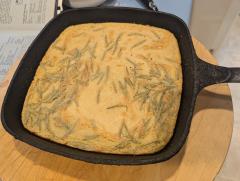 arinata is a crispy thin bread of chickpea four and water, cooked in an oiled skillet at high temperature. It's gluten-free, so it's not like most breads, but it's too crispy to be called a pancake. It has a natural sweetness, but I still classify it as a savory dish. In Liguria and along the northern Tuscan coast of the Tyrrhenian Sea as far as Pisa it's a street food, but we're not so familiar for it to have "bred contempt", so with good technique and quality ingredients it can go nicely with any assortment of aperitivi.
arinata is a crispy thin bread of chickpea four and water, cooked in an oiled skillet at high temperature. It's gluten-free, so it's not like most breads, but it's too crispy to be called a pancake. It has a natural sweetness, but I still classify it as a savory dish. In Liguria and along the northern Tuscan coast of the Tyrrhenian Sea as far as Pisa it's a street food, but we're not so familiar for it to have "bred contempt", so with good technique and quality ingredients it can go nicely with any assortment of aperitivi.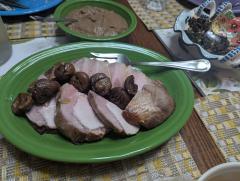 This recipe is not difficult and the flavors are wonderful! This would be perfectly suitable for a dinner during the holiday season.
This recipe is not difficult and the flavors are wonderful! This would be perfectly suitable for a dinner during the holiday season. This is the most famous of the Italian recipes for oxtail. It's got incredible rich flavor from slow cooking the meat with tomatoes and vegetables, and then finishing it with pine nuts, golden raisins, and bitter chocolate!
This is the most famous of the Italian recipes for oxtail. It's got incredible rich flavor from slow cooking the meat with tomatoes and vegetables, and then finishing it with pine nuts, golden raisins, and bitter chocolate!